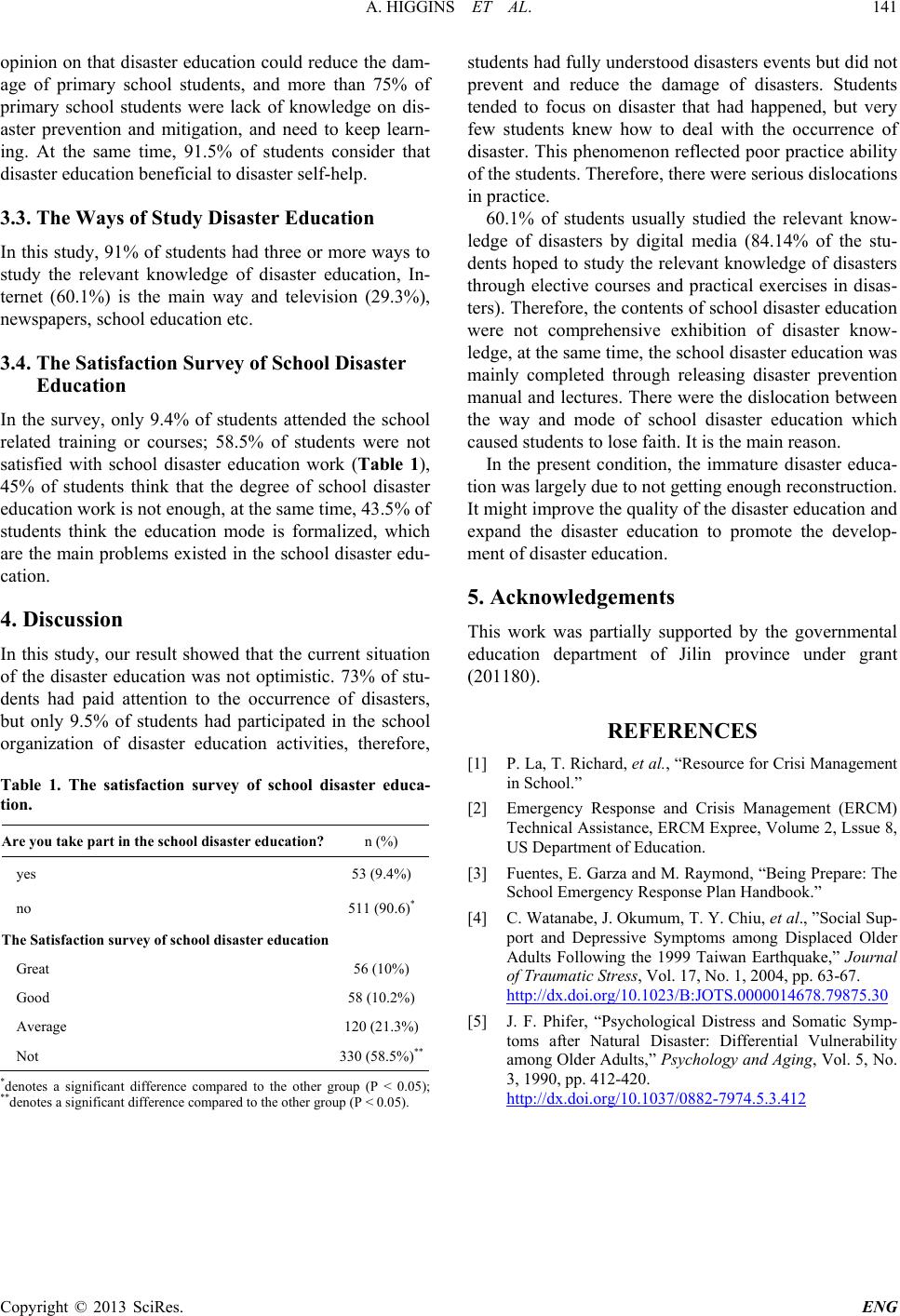
A. HIGGINS ET AL.
Copyright © 2013 SciRes. ENG
opinion on that disaster education could reduce the dam-
age of primary school students, and more than 75% of
primary school students were lack of knowledge on dis-
aster prevention and mitigation, and need to keep learn-
ing. At the same time, 91.5% of students consider that
disaster education beneficial to disas ter self-help.
3.3. The Ways of Study Disaster Education
In this study, 91% of students had three or more ways to
study the relevant knowledge of disaster education, In-
ternet (60.1%) is the main way and television (29 .3%),
newspapers, school education etc.
3.4. The Satisfaction Survey of School Disaster
Education
In the survey, only 9.4% of students attended the school
related training or courses; 58.5% of students were not
satisfied with school disaster education work (Table 1),
45% of students think that the degree of school disaster
education work is not enough, at the same time, 43.5 % of
students think the education mode is formalized, which
are the main problems existed in the s chool disaster edu-
cation.
4. Discussion
In this study, our result showed that the current situation
of the disaster education was not optimistic. 73% of stu-
dents had paid attention to the occurrence of disasters,
but only 9.5% of students had participated in the school
organization of disaster education activities, therefore,
Table 1. The satisfaction survey of school disaster educa-
tion.
Are you take part in the school disaster education? n (%)
yes 53 (9.4%)
no 511 (90.6)*
The Satisfaction survey of school disaster education
Great 56 (10%)
Good 58 (10.2%)
Average 120 (21.3%)
Not 330 (58.5%)**
*denotes a significant difference compared to the other group (P < 0.05);
**denotes a signifi cant difference c ompared to the other group (P < 0.05).
students had fully understood disasters events but did not
prevent and reduce the damage of disasters. Students
tended to focus on disaster that had happened, but very
few students knew how to deal with the occurrence of
disaster. This phenomenon reflected poor practice ability
of the students. Therefore, there were serious dislocation s
in practice.
60.1% of students usually studied the relevant know-
ledge of disasters by digital media (84.14% of the stu-
dents hoped to study the relevant knowledge of disasters
through elective courses and practical exercises in disas-
ters). Therefore, the contents of school disaster education
were not comprehensive exhibition of disaster know-
ledge, at the same time, the school disaster education was
mainly completed through releasing disaster prevention
manual and lectures. There w ere the dislocation between
the way and mode of school disaster education which
caused students to lose faith. It is the main reason.
In the present condition, the immature disaster educa-
tion was largely due to not getting enough reconstruction.
It might improve the quality of the d isaster educ ation and
expand the disaster education to promote the develop-
ment of disaster education.
5. Acknowledgements
This work was partially supported by the governmental
education department of Jilin province under grant
(201180).
REFERENCES
[1] P. La, T. Richard, et al ., “Resource for Crisi Management
in School.”
[2] Emergency Response and Crisis Management (ERCM)
Technical Assistance, ERCM Expree, Volume 2, Lssue 8,
US Department of Education.
[3] Fuentes, E. Garza and M. Raymond, “Being Prepare: The
School Emergency Response Plan Handbook.”
[4] C. Watanabe, J. Okumum, T. Y. Chiu, et al., ”Social Sup-
port and Depressive Symptoms among Displaced Older
Adults Following the 1999 Taiwan Earthquake,” Journal
of Traumatic Stre ss, Vol. 17, No. 1, 2004, pp. 63-67.
http://dx.doi.org/10.1023/B:JOTS.0000014678.79875.30
[5] J. F. Phifer, “Psychological Distress and Somatic Symp-
toms after Natural Disaster: Differential Vulnerability
among Older Adults,” Psychology and Aging, Vol. 5, No.
3, 1990, pp. 412-420.
http://dx.doi.org/10.1037/0882-7974.5.3.412